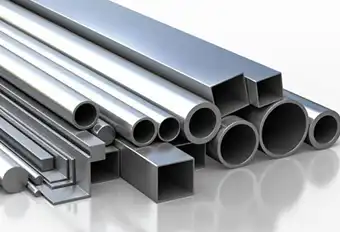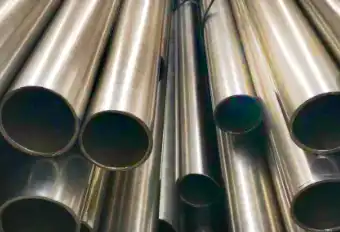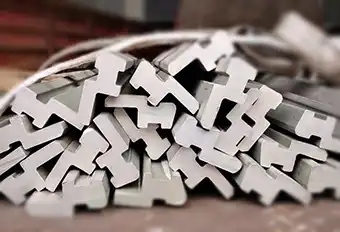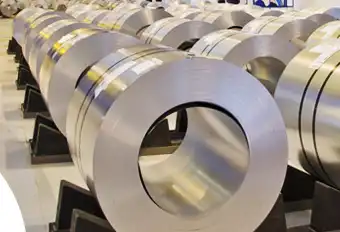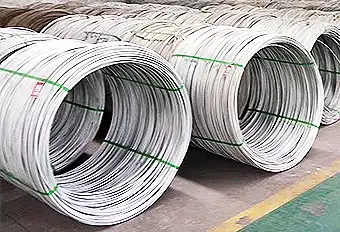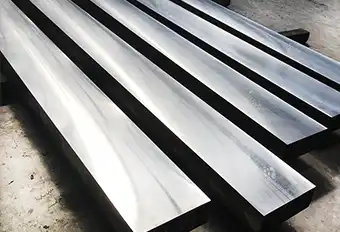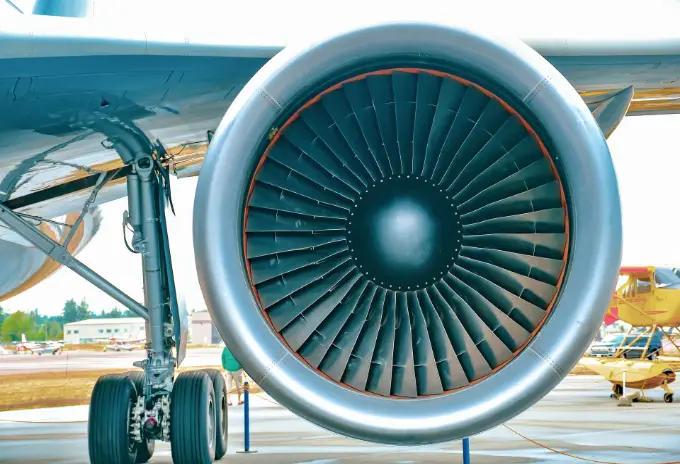A designation is the specific identification of each grade, type, or class of steel by a number, letter, symbol, name, or suitable combination. Unique to a particular steel grade, type and class are terms used to classify steel products. Within the steel industry, they have very specific uses: grade is used to denote chemical composition; type is used to indicate deoxidation practice; and class is used to describe some other attribute, such as strength level or surface smoothness.
In ASTM specifications, however, these terms are used somewhat interchangeably. In ASTM A 533, for example, type denotes chemical composition, while class indicates strength level. In ASTM A 515, grade identifies strength level; the maximum carbon content permitted by this specification depends on both plate thickness and strength level. In ASTM A 302 grade denotes requirements for both chemical composition and mechanical properties. ASTM A 514 and A 5117 are specifications for high-strength quenched and tempered plate for structural and pressure vessel applications, respectively, each contains several compositions that can provide the required mechanical properties. However, A 514 type A has the identical composition limits as A 517 grade.
Chemical composition is by far the most widely used basis for classification and/or designation of steels. The most commonly used system of designation in the United States is that of the Society of Automotive Engineers (SAE) and the American Iron and Steel Institute (AISI). The Unified Numbering System (UNS) is also being used with increasing frequency.
SAE-AISI Designations
As stated above, the most widely used system for designating carbon and alloy steels is the SAE-AISI system. As a point of technicality, there are two separate systems, but they are nearly identical and have been carefully coordinated by the two groups. It should be noted, however, that AISI has discontinued the practice of designating steels.
The SAE-AISI system is applied to semi-finished forgings, hot-rolled and cold-finished bars, wire rod and seamless tubular goods, structural shapes, plates, sheet, strip, and welded tubing.
Carbon steels contain less than 1.65% Mn, 0.60% Si, and 0.60% Cu; they comprise the lxxx groups in the SAE-AISI system and are subdivided into four distinct series as a result of the difference in certain fundamental properties among them.
Designations for merchant quality steels include the prefix M. A carbon steel designation with the letter B inserted between the second and third digits indicates the steel contains 0.0005 to 0.003% B. Likewise, the letter L inserted between the second and third digits indicates that the steel contains 0.15 to 0.35% Pb for enhanced machinability. Resulfurized carbon steels of the 11xx group and resulfurized and rephosphorized carbon steels of the 12xx group are produced for applications requiring good machinability. Steels that having nominal manganese contents of between 0.9 and 1.5% but no other alloying additions now have 15xx designations in place of the 10xx designations formerly used.
Alloy steels contain manganese, silicon, or copper in quantities greater than those listed for the carbon steels, or they have specified ranges or minimums for one or more of the other alloying elements. In the AISI-SAE system of designations, the major alloying elements are indicated by the first two digits of the designation. The amount of carbon, in hundredths of a percent, is indicated by the last two (or three) digits.
For alloy steels that have specific hardenability requirements, the suffix H is used to distinguish these steels from corresponding grades that have no hardenability requirement. As with carbon steels, the letter B inserted between the second and third digits indicates that the steel contains boron. The prefix E signifies that the steel was produced by the electric furnace process.
HSLA Steels. Several grades of HSLA steel are described in SAE Recommended Practice J410. These steels have been developed as a compromise between the convenient fabrication characteristics and low cost of plain carbon steels and the high strength of heat-treated alloy steels. These steels have excellent strength and ductility as-rolled.
UNS Designations The Unified Numbering System (UNS) has been developed by ASTM and SAE and several other technical societies, trade associations, and United States government agencies.
A UNS number, which is a designation of chemical composition and not a specification, is assigned to each chemical composition of a metallic alloy. The UNS designation of an alloy consists of a letter and five numerals. The letters indicate the broad class of alloys; the numerals define specific alloys within that class. Existing designation system, such as the AISI-SAE system for steels, have been incorporated into UNS designations. UNS is described in greater detail in SAE J1086 and ASTM E 527.
AMS Designation
Aerospace Materials Specifications (AMS), published by SAE, are complete specifications that are generally adequate for procurement purposes. Most of the AMS designations pertain to materials intended for aerospace applications; the specifications may include mechanical property requirements significantly more severe than those for grades of steel having similar compositions but intended for other applications. Processing requirements, such as for consumable electrode remelting, are common in AMS steels.
ASTM (ASME) Specifications The most widely used standard specifications for steel products in the United States are those published by ASTM. These are complete specifications, generally adequate for procurement purposes. Many ASTM specifications apply to specific products, such as A 574 for alloy steel socket head cap screws. These specifications are generally oriented toward performance of the fabricated end product, with considerable latitude in chemical composition of the steel used to make the end product.
ASTM specifications represent a consensus among producers, specifiers, fabricators, and users of steel mill products. In many cases, the dimensions, tolerances, limits, and restrictions in the ASTM specifications are similar to or the same as the corresponding items of the standard practices in the AISI Steel Products Manuals.
Many of the ASTM specifications have been adopted by the American Society of Mechanical Engineers (ASME) with little or no modification; ASME uses the prefix S and the ASTM designation for these specifications. For example, ASME-SA213 and ASTM A 213 are identical.
Steel products can be identified by the number of the ASTM specification to which they are made. The number consists of the letter A (for ferrous materials) and an arbitrary, serially assigned number. Citing the specification number, however, is not always adequate to completely describe a steel product. For example, A 434 is the specification for heat-treated (hardened and tempered) alloy steel bars. To completely describe steel bars indicated by this specification, the grade (SAE-AISI designation in this case) and class (required strength level) must also be indicated. The ASTM specification A 434 also incorporates, by reference, two standards for test methods (A 370 for mechanical testing and E 112 for grain size determination) and A 29, which specifies the general requirements for bar products.
SAE-AISI designations for the compositions of carbon and alloy steels are sometimes incorporated into the ASTM specifications for bars, wires, and billets for forging. Some ASTM specifications for sheet products include SAE-AISI designations for composition. The ASTM specifications for plates and structural shapes generally specify the limits and ranges of chemical composition directly, without the SAE.AISI designations.
General Specifications. Several ASTM specifications, such as A 20 covering steel plate used for pressure vessels, contain the general requirements common to each member of a broad family of steel products. These general specifications are often supplemented by additional specifications describing a different mill form or intermediate fabricated product.
European and Japanese Designation Systems
Below some basics of European and Japanese designation systems are explained. Please refer to articles about corresponding national and international standards for more details.
DIN standards are developed by Deutsches Institut fur Normung in the Federal Republic of Germany. All West German steel specifications are preceded by the uppercase letters DIN followed an alphanumeric or numeric code. The latter method, known as the Werkstoff number, uses numbers only with a decimal point after the first digit.
JIS standards are developed by the Japanese Industrial Standards Committee, which is part of the Ministry of International Trade and Industry in Tokyo. The JIS steel specifications begin with the uppercase letters JIS and are followed by an uppercase letter (G in the case of carbon and low-alloy steels) designating the division (product form) of the standard. This letter is followed by a series of numbers and letters that indicate the specific steel.
British standards (BS) are developed by the British Standards Institute in London, England. Similar to the JIS standards, each British designation includes a product form and an alloy code.
AFNOR standards are developed by the Association Francaise de Normalisation in Paris, France. The correct format for reporting AFNOR standards is as follows. An uppercase NF is placed to the left of the alphanumeric code. This code consists of an uppercase letter followed by a series of digits, which are subsequently followed by an alphanumeric sequence.
UNI standards are developed by the Ente Nazionale Italiano di Unificazione in Milan, Italy. Italian standards are preceded by the uppercase letter UNI followed by a four-digit product form code subsequently followed by an alphanumeric alloy identification.
Swedish standards (SS) are prepared by the Swedish Standards Institution in Stockholm. Designations begin with the letters SS followed by the number 14 (all Swedish carbon and low-alloy steels are covered by SS14). What subsequently follows is a four digit numerical sequence similar to the German Werkstoff number.


